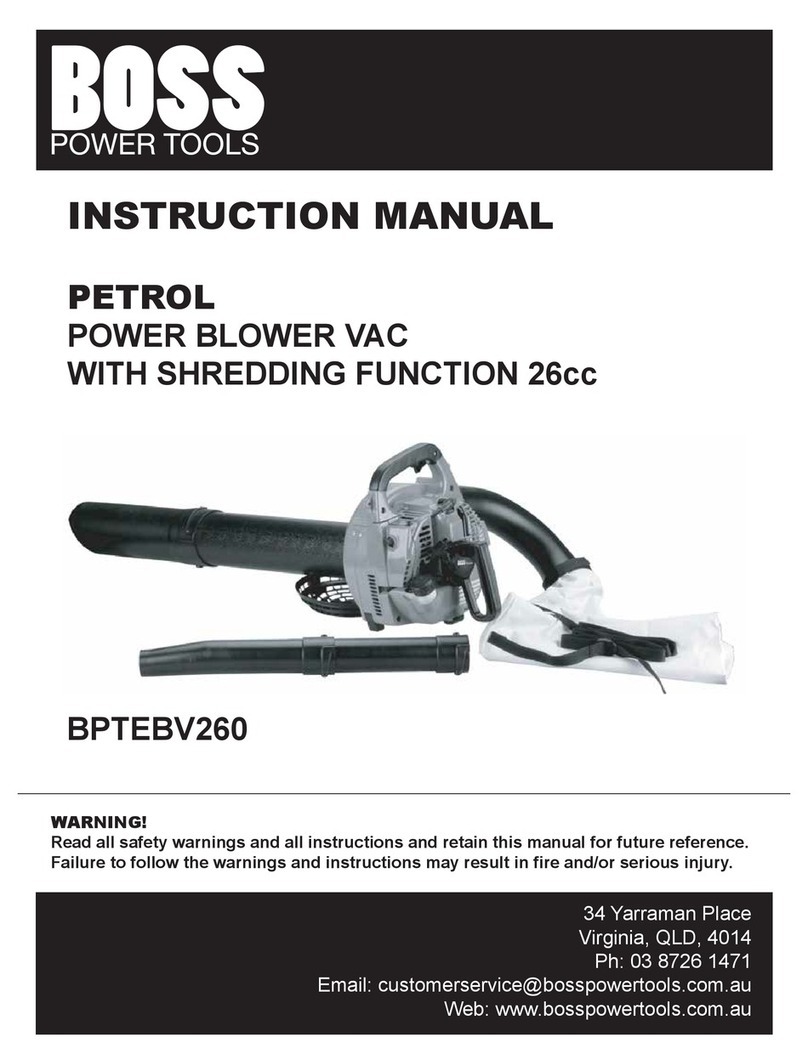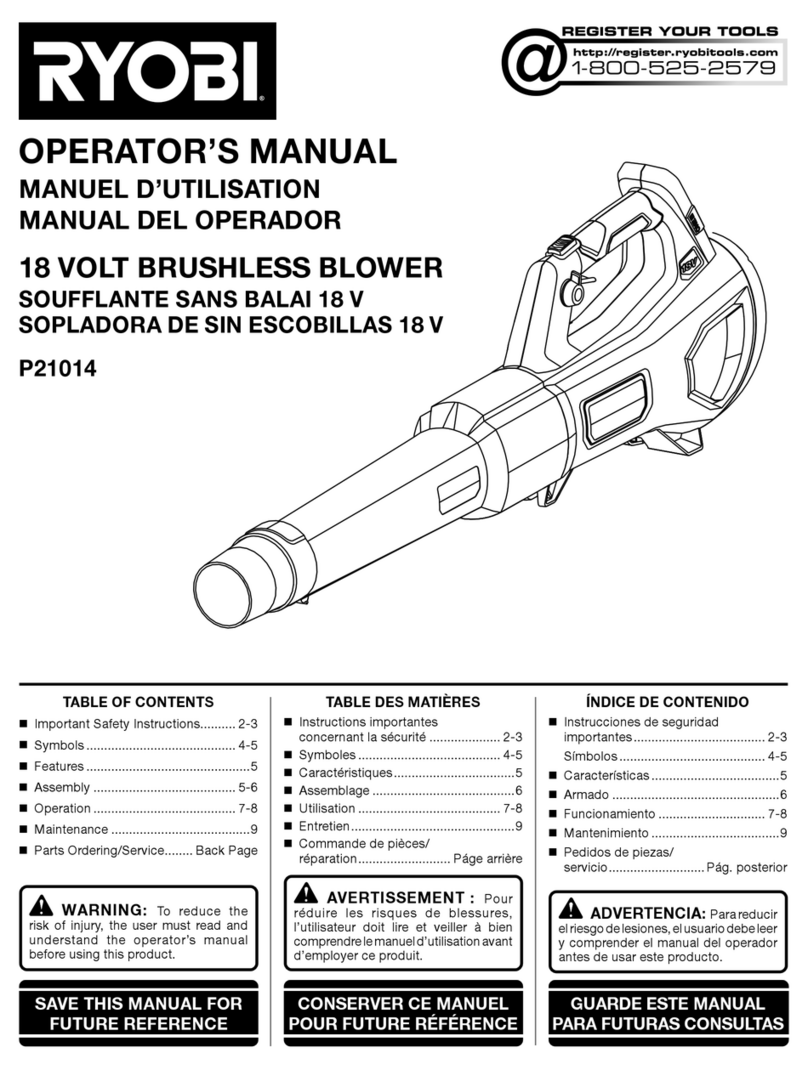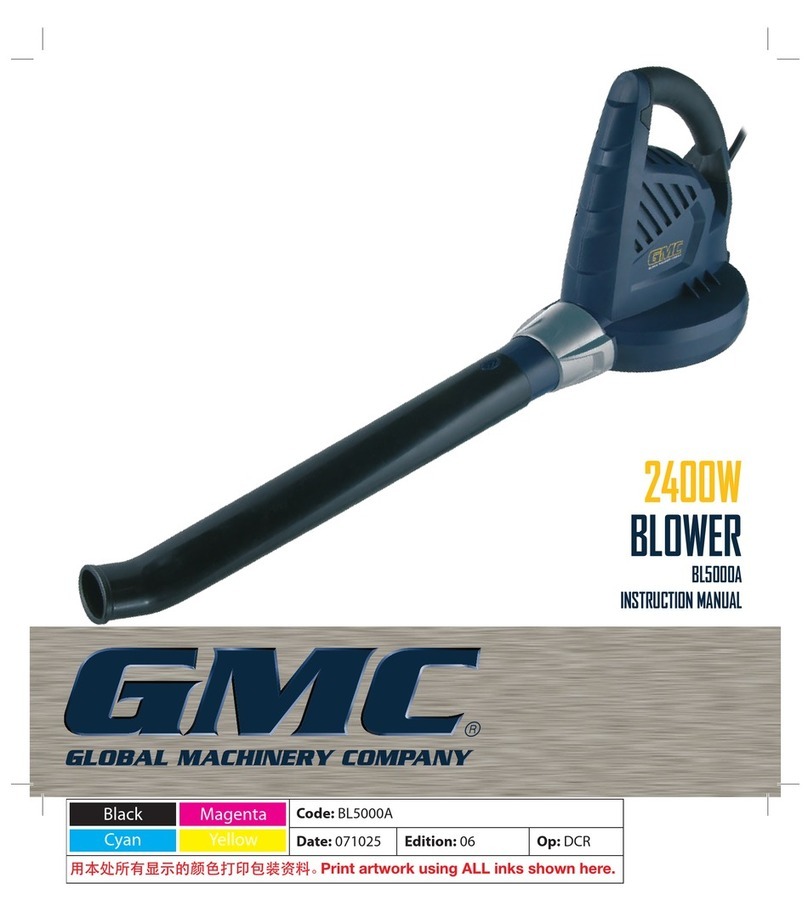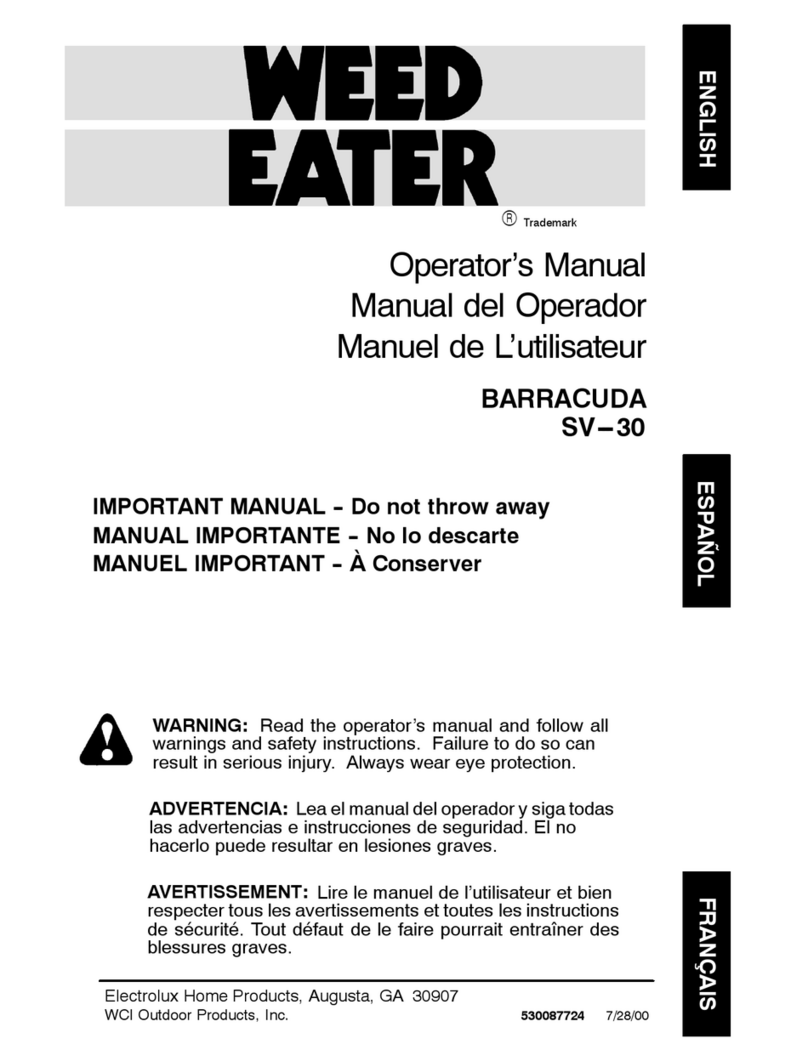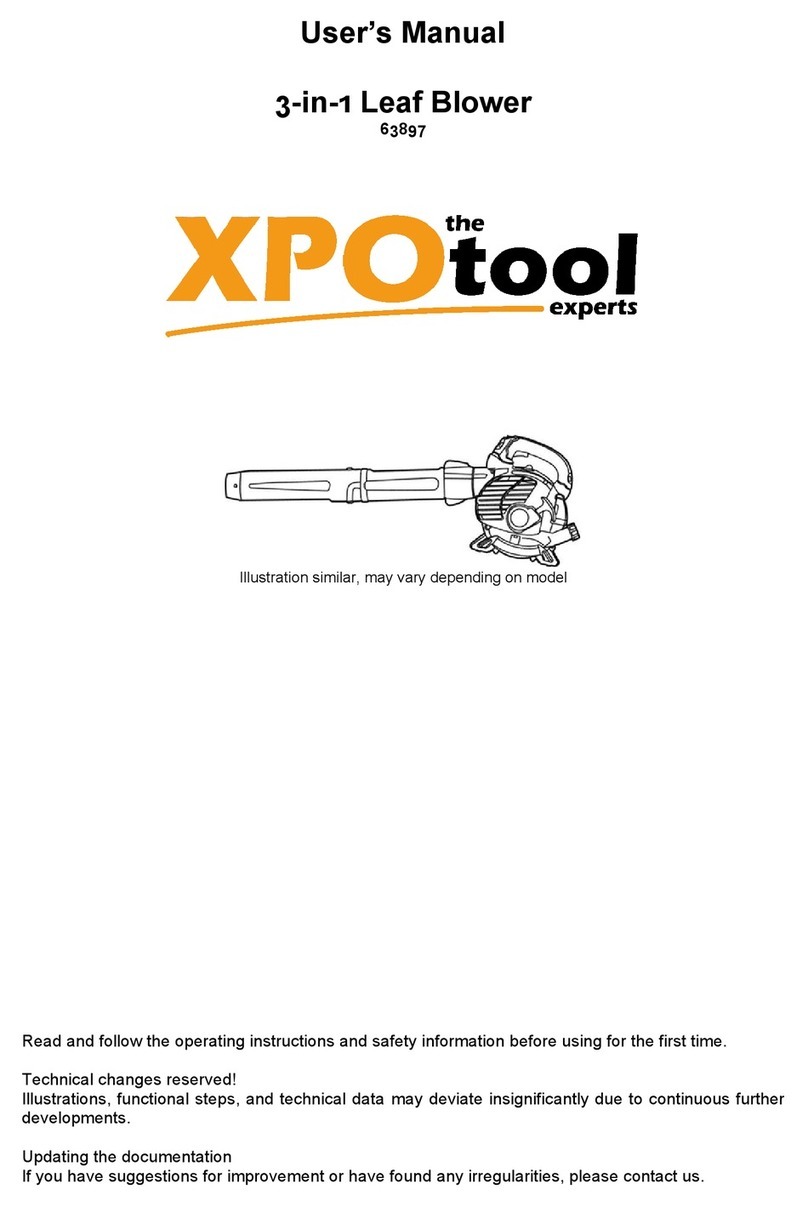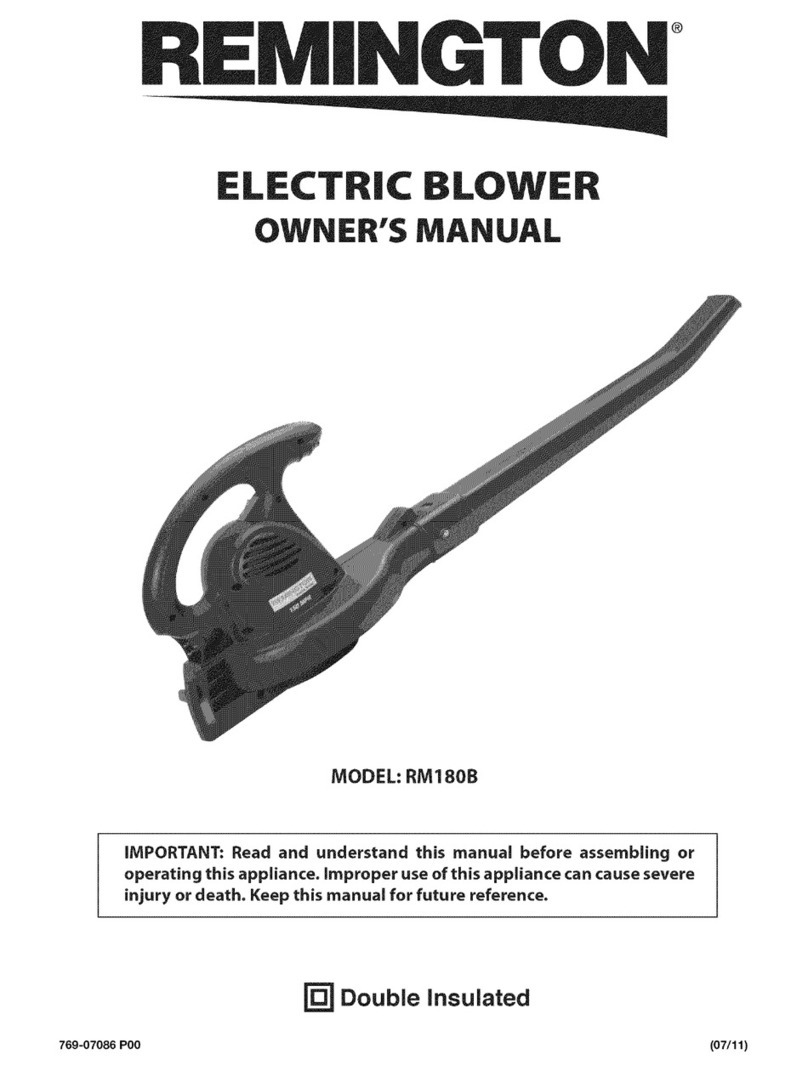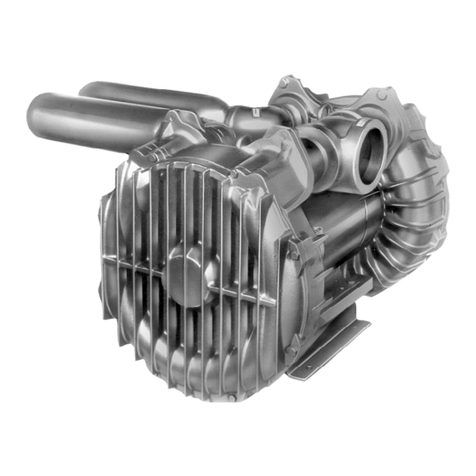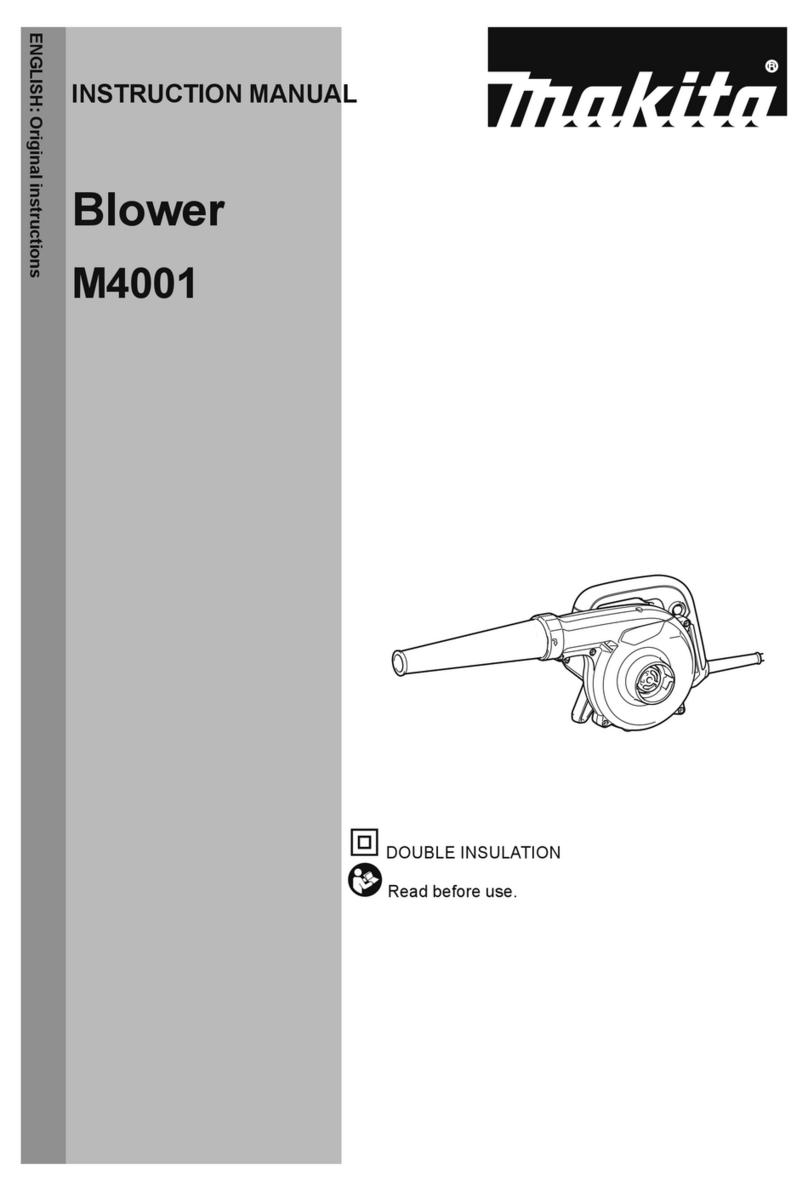BOSSCO BPTPB40 User manual

Operating Instructions - Translation of the original Operating Instructions
Read operating instructions before use!
GB
34 Yarraman Place
Virginia, QLD, 4014
Ph: 03 8726 1471
Email: [email protected]
Web: www.bosspowertools.com.au
INSTRUCTION MANUAL
LITHIUM-ION
LEAF BLOWER
BPTPB40

GB-1
CONTENT Page
Illustrations 1 - 4
Proper use GB-2
Safety information GB-2
• Work area GB-2
• Electrical safety GB-2
• Personal safety GB-2
• Power tool use and care GB-3
• Appropriate handling and use of battery-operated power tools GB-3
• Service GB-3
• Safety instructions for the charger and rechargeable battery
GB-3
• General safety instructions
GB-4
• Additional safety instructions for leaf blowers
GB-5
Explanation of symbols GB-7
Unpacking GB-9
Assembly GB-9
• Installing and removing the rechargeable battery GB-9
• Installing the blow tube GB-9
Operation GB-9
• Starting and stopping GB-9
• Blowing function GB-9
• Working advice GB-9
Cleaning and Storage GB-9
Waste disposal and environmental protection GB-9
Warranty GB-9
Spare parts GB-10
Technical Specications GB-11
Declaration of Conformity GB-12
Service
Cordless Leaf Blower ALB 40
ENGLISH
Translation of the original Operating Instructions
Your leaf blower was developed and manufactured in accordance with the latest innovations and
with high-quality materials to ensure a long lifespan and problem-free use whilst assuring the
safety of the user. If it is maintained properly, your leaf blower (leaf vacuum) will give you years
of good service.

GB-2
Proper use:
The leaf blower is intended for blowing leaves
together in a desired direction or blowing them
away from hard-to-reach places. The device is
not suitable for use in buildings.
The device must not be used by children or
inrm persons without supervision.
Charging the rechargeable battery
Only charge the rechargeable battery block
with the charger provided by the manufacturer.
To protect against the danger of electrical
shock, injury and burns, read and understand
this operating manual completely before you
charge the battery.
Improper use
All uses of the device which are not stated in
the section ‘Proper use’ are considered im-
proper use.
The leaf blower (leaf vacuum) must not be
used for the following purposes:
- Use in enclosed spaces
- Use as a fan
- Grooming pet animals
There is a danger of injury.
The user of the device is liable for all property
damage and personal injury resulting from im-
proper use.
Use of other or non-original parts on the ma-
chine voids the manufacturer’s warranty.
Residual risks
Even if the tool is used properly, there is al-
ways a residual risk that cannot be excluded.
Due to the type and design of the tool, the fol-
lowing potential dangers may result:
- Unintentional starting of the product
- Objects being hurled away by the air jet
- Hearing damage if suitable hearing protec-
tion is not worn
- Inhalation of leaves, dust and whirled-up
particles
If the instructions contained in this instruction
manual are not observed, other residual risks
may result due to improper use.
Safety information
WARNING. Read and understand all instruc-
tions. Failure to follow all instructions listed
below may result in electric shock, re and/or
serious injury. The term “power tool” in all of
the warnings below refers to your mains-op-
erated (corded) power tool or battery-operated
(cordless) power tool.
Save these instructions
Work area
• Keep work area clean and well lit. Clut-
tered and dark areas invite accidents.
• Do not operate power tools in explosive
atmospheres, such as in the presence of
ammable liquids, gases, or dust. Power
tools create sparks which may ignite the dust
or fumes.
• Keep children and bystanders away while
operating a power tool. Distractions can
cause you to lose control.
Electrical safety
• Avoid body contact with earthed or
grounded surfaces such as pipes, radia-
tors, ranges and refrigerators. There is an
increased risk of electric shock if your body
is earthed or grounded.
• Do not expose power tools to rain or wet
conditions. Water entering a power tool will
increase the risk of electric shock.
Personal safety
• Stay alert, watch what you are doing and
use common sense when operating a
power tool. Do not use a power tool while
you are tired or under the inuence of drugs,
alcohol, or medication. A moment of inatten-
tion while operating power tools may result
in serious personal injury.
• Use safety equipment. Always wear eye
protection. Safety equipment such as a dust
mask, non-skid safety shoes, hard hat, or
hearing protection used for appropriate con-
ditions will reduce personal injuries.
• Avoid unintentional operation. Make sure
that the power tool is switched off before
you connect it to the mains supply and/or
the battery and whenever you pick up or
carry the tool. When carrying the tool with

GB-3
your nger on the on/off switch or connecting
the tool to the mains supply with the switch
in ‘ON’ position, this may result in accidents.
• Remove any adjusting key or wrench be-
fore turning the tool on. A wrench or a key
that is left attached to a rotating part of the
power tool may result in personal injury.
• Do not overreach. Keep proper footing and
balance at all times. This enables better con-
trol of the power tool in unexpected situations.
• Dress properly. Do not wear loose cloth-
ing or jewellery. Keep your hair, clothing
and gloves away from moving parts. Loose
clothes, jewellery or long hair can be caught
in moving parts.
• If devices are provided for the connection
of dust extraction and collection facili-
ties ensure that these are connected and
properly used. Use of these devices can
reduce dust-related hazards.
Power tool use and care
•Do not force the power tool. Use the cor-
rect power tool for your application. The
correct power tool will do the job better and
safer at the rate for which it was designed.
•Do not use the power tool if the switch
does not turn it on and off. Any power tool
that cannot be controlled with the switch is
dangerous and must be repaired.
• Pull the mains plug and/or remove the
battery before adjusting a tool, changing
accessories or putting the tool aside. This
precaution avoids the unintentional start of
the tool.
•Store idle power tools out of the reach
of children and do not allow persons
Unfamiliar with the power tool or these
instructions to operate the power tool.
Power tools are dangerous in the hands of
untrained users.
•Maintain power tools. Check for misalign-
ment or binding of moving parts, breakage of
parts and any other condition that may affect
the power tool’s operation. If damaged, have
the power tool repaired before use, Many
accidents are caused by poorly maintained
power tools.
•Use the power tool, accessories and
tool bits etc., in accordance with these
instructions and in the manner intended
for the particular type of power tool, tak-
ing into account the working conditions
and the work to be performed. Use of the
power tool for operations different from in-
tended could result in a hazardous situation.
Appropriate handling and use of battery-
operated power tools
• Make sure that the device has been
switched off before inserting the battery.
Inserting a battery into a switched-on power
tool may lead to accidents!
• Only use charging devices recommended
by the manufacturer to charge the batter-
ies. Charging units are usually designed for
certain types of batteries; if used with other
types there is a risk of re!
• Only use batteries designed for your
power tool. The use of other batteries may
lead to injury and risk of re!
• Keep unused batteries clear of paper
clips, coins, keys, nails, screws or other
small metal objects that may bridge the
contacts. A short circuit between the battery
contacts may lead to burns or re!
• Improper use may result in uid leaking
out of the battery. Avoid any contact with
battery uid. Flush with water in case of
contact. If battery uid should get into
your eyes seek medical advice addition-
ally. Leaking battery uid may lead to irrita-
tions of the skin or burns!
Service
• Have your power tool serviced by a quali-
ed repair personnel using only identical
replacement parts. This will ensure that the
safety of the power tool is maintained.
Safety instructions for the charger and re-
chargeable battery
• Read the guidelines and safety information
before charging the rechargeable battery.
• Only use the prescribed charger to charge the
rechargeable battery.
• Do not charge any other rechargeable bat-
teries with this charger. Only use the charger
together with the corresponding rechargeable
battery.
• Only use the charger in a dry environment at a
temperature between 10 °C and 40 °C.

GB-4
• Never use a damaged charger.
• Only permit an authorised repair shop to repair
the charger or rechargeable battery.
• Prevent short circuits of the rechargeable
battery. Ensure that the rechargeable battery
terminals never come into contact with metal
objects.
• Do not store the rechargeable battery in loca-
tions where the temperature can reach 50
°C, for example, in an automobile parked in
the sun.
• Do not expose the charger or the rechargeable
battery to moisture.
• Never burn the rechargeable battery.
• Never attempt to open the rechargeable bat-
tery.
• If the uid in the rechargeable battery (a 25
to 30 % potassium hydroxide solution) comes
into contact with the skin, immediately ush
the affected area with plenty of water. Neutral-
ise the solution with a mild acid such as lemon
juice or vinegar. If the solution comes into
contact with the eyes, ush them for at least
10 minutes with running water and consult
with a doctor.
Dispose of batteries properly:
This product must not be disposed of with
household waste. Old devices contain valu-
able recyclable material which should be taken
for re-utilisation and to prevent damage to the
environment and human health by uncontrolled
waste disposal. Therefore, please dispose of old
devices through suitable collection systems or
send the device to the location you purchased
it for disposal. Your device will then be taken for
material recycling. Do not simply throw your elec-
trical tool in the waste bin after its long lifespan,
but dispose of it in an environmentally friendly
manner.
Leaking batteries:
If a rechargeable battery cell leaks, be certain
the escaping uid does not come into contact
with the skin or eyes.
If it does, ush the affected area with plenty of
water and consult with a doctor.
Wipe up escaped uid with a dry cloth and dis-
pose of it together with the old device through a
suitable collection system.
General safety instructions
• This machine is not intended for use by per-
sons (including children) with an impaired
physical, sensory or mental capacity or
insufcient experience and/or insufcient
knowledge unless they are supervised by
a person responsible for their safety or
receive instructions from that person in the
use of the machine.
• Children should be supervised in order to en-
sure that they do not play with the machine.
1) Instructions
1. Read these instructions carefully. Familiarise
yourself with the control elements and the
correct use of the device.
2. Never permit children to use the device.
3. Never permit persons who are not familiar
with these operating instructions to use this
device. Local regulations can restrict the age
of the operator.
4. Never operate the device whilst other per-
sons, in particular children or pet animals,
are nearby.
5. The operator or user is responsible for ac-
cidents or dangers to other persons or their
property.
2) Preparation
1. Always wear appropriate footwear and long
trousers whilst operating the device.
2. Wear proper clothing – never wear loose
clothing or jewellery. They may get caught in
moving parts. The use of rubber gloves and
suitable footwear is recommended for work-
ing outdoors.
3. Wear hair protection to hold back long hair.
Wear protective goggles during operation.
4. Wearing a dust mask is recommended to
prevent irritation from dust.
5. Never operate the device with damaged pro-
tective shields or covers safety devices or
without properly installed safety devices, such
as the attached rubbish collector.
3) Operation
1. Remove the rechargeable batteries:
- when the device is not being used, when
transporting it or when it is left unattended;
- when checking, cleaning or removing block-
age from the device;
- when you carry out cleaning or maintenance
work or exchange accessories;

GB-5
- after contact with foreign objects or if there
is abnormal vibration.
2. Avoid dangerous environments – never use
the device in moist or wet environments.
3. Only operate the device during daylight or
with good articial lighting.
4. Do not overreach and always keep your bal-
ance.
5. On slopes, make sure you always have rm,
stable footing.
6. Walk, never run.
7. Keep all coolant air intakes free of contami-
nation.
8. Never blow rubbish towards bystanders.
4) Maintenance and storage
Before performing any cleaning or maintenance,
switch off the device and remove the recharge-
able battery.
1. Keep all nuts, bolts and screws clean to
ensure the device is always in good working
condition.
2. Check the device for wear or deterioration
regularly.
3. Replace parts that are worn out or damaged.
4. Only use original spare parts and acces-
sories.
5. When not in operation, store devices indoors
after they have come to a complete stop;
devices should be stored indoors in dry, el-
evated or enclosed places beyond the reach
of children.
Additional safety instructions for leaf
blowers
- The device is only intended for private use. It
must not be used in public green areas, park
areas, sport facilities, on median strips, or for
landscaping or forestry.
- Only operate the machine at reasonable times
of the day; not early in the morning or late in
the evening when others could be disturbed.
Times specied by local authorities are to be
observed.
- A tingling feeling or numbness in the hands
is sign of excessive vibration. Limit the
operating time, take sufciently long work
breaks, distribute the work between several
people or wear anti-vibration gloves when
using the tool for extended periods.
- A certain degree of noise from this device is
unavoidable. Perform noise-intensive work
at times when this is permitted and at times
intended for this type of work. Where ap-
plicable, observe quiet times and limit work-
ing time to the absolute minimum. You and
other persons in the area where the trimmer
is being used should wear suitable hearing
protection.
- Always operate the machine at the lowest
motor speed necessary to carry out the work.
- Before starting blowing, remove foreign ob-
jects with rake and broom.
- In dusty conditions, lightly moisten the surface
or, when available, use a watering attachment
part.
- Use the entire blowing nozzle attachment so
the air jet can work close to the ground.
- Watch out for children, pet animals and open
windows; blow foreign objects away safely.
Preparation:
1. Before starting work, always ensure your
device is in awless condition. Do not work
with your leaf blower if any part of the device
is defective or worn out.
2. Keep other persons, particularly children or
pet animals, away from the running device.
Keep such persons at least 6 m away from
your work area.
3. Clear away sharp-edged, pointed or smoul-
dering materials before starting work.
4. Prevent unintended start-up: Make sure that
the switch is set to the off position before con-
necting to the power supply.
Operation:
1. Never operate the machine barefoot or whilst
wearing open sandals. Always wear sturdy
footwear or boots to protect your feet – freshly
cut grass is moist and slippery. Rubber or
hand-made shoes increase safety. Wear long
trousers to protect your legs. Always wear
safety goggles or corresponding safety eye-
wear when working with the leaf blower. Wear
hearing protection as soon as the noise level
of the work becomes uncomfortable.
2. Put up long hair so it does not reach below
your shoulders. Keep loosely tting clothing,
ties, tassels and dangling belts away from
openings and moving parts.
3. Never point the tube towards persons or
windows.

GB-6
4. Only use the machine for its intended purpose
as described here.
5. Switch off the device before mounting or dis-
mounting the blow tube. Wait until the motor
has stopped.
6. Always make sure to keep a stable stance
and do not lose your balance – especially
when you are working on slopes.
Maintenance and repair:
1. Switch off the device after use and before
each time it is cleaned.
2. Do not attempt to repair the device. Only
have repairs done by a specialist or customer
service.
3. Only use original spare parts and acces-
sories. Use of accessory parts not express-
ly recommended by the manufacturer can
cause injury or damage.
4. Always store the leaf blower in a dry location
beyond the reach of children. Never expose
the device to any solvents.

GB-7
Explanation of symbols
The following symbols are used on this electric tool. You can operate this electric tool more safely and effectively
with the correct interpretation of these symbols.
SYMBOLE DESCRIPTION
WARNING SYMBOL
Indicates danger, safety notes or causes for particular caution. This symbol may occur in
combination with other symbols or pictograms.
If you do not adhere to the instructions and safety measures described in the Operating
Instructions severe injuries may occur. Read the Operating Instructions before you start and
operate this device.
Do not use the tool under wet weather conditions!
WEAR EYE AND EAR PROTECTION
WARNING: Thrown-about objects may lead to serious injuries of the eyes, heavy noise
may lead to hearing losses. Always wear eye and ear protection when operating this device.
DANGER OF INJURY !
Beware of hurled-away objects.
Keep bystanders away.
KEEP OTHER PERSONS IN DISTANCE
WARNING: When operating the device, take care that no other persons are nearby (safe
distance: 5m). This is particularly valid for children and animals.
WARNING!
Rotating Fans. Keep hands and feet out of the openings while the machine is running.
WARNING!
Dangerous feed orice. Keep hands and feet out of the openings while the machine is
running.
Always remove the rechargeable battery before inspection and adjustment work.
Observe a safety distance of at least 5 m from other persons.
This device may not be disposed of with general/household waste. Dispose of only at a
designated collection point.

GB-8
SYMBOL DESCRIPTION
Conrms the conformity of the electric tool with the Directives of the European Community.
guaranted acoustic capacity level LWA 96 dB(A)

GB-9
Unpacking
Due to modern mass production techniques, it is unlikely
that your power tool is faulty or that a part is missing. If
you nd anything wrong, do not operate the tool until the
parts have been replaced or the fault has been rectied.
Failure to do so could result in serious personal injury.
Assembly
Installing and removing the rechargeable battery
Always switch the tool off before you insert or re-
move the rechargeable battery.
1. If you want to remove the rechargeable battery from
the tool, press the locking buttons on both sides and
pull the rechargeable battery from the tool (Fig. 1).
2. To insert the rechargeable battery in the tool, rst line
up the base of the rechargeable battery with the guide
on the housing (Fig. 2). Then push the rechargeable
battery rmly into the tool (Fig. 1) until you hear the
locking click into place. If the rechargeable battery is
not locked into place, you or other persons may be
injured.
Warning: Only use the rechargeable battery provi-
ded by the manufacturer.
Installing the blow tube (Fig. 3)
Do not use the device until the blow tube has been
properly mounted on the blower housing.
1. Push the blow tube with the guide pins (A) over the
two guide dimples (B) on the blower housing.
2. Rotate the tube clockwise until it locks into place.
Operation
Starting and stopping (Fig. 4)
1. Starting: Press down the switch safety lock (1) and
then press the switch (2). The switch safety lock (1)
does not need to be kept pressed during operation.
2. The blowing speed can be steplessly adjusted with
the rotary knob (4).
3. After the device has been switched on, the highest
blowing speed can be switched to by pressing the
turbo switch (3).
Blowing function
• Before setting the device into operation, always check
it for awless condition.
• Examine the work area before starting work. Use a
rake or broom to remove all objects or wastes which
could be hurled away by the leaf blower.
• If needed, lightly moisten dusty ground.
Working advice (Fig. 5)
• Hold the leaf blower about 20 cm above the ground
as shown in Figure 5, switch on the device and swing
it easily from side to side. Blow waste material into a
heap. Do not direct the air jet into the middle of the
waste heap.
• Adjust the blowing power to the requirements.
• Make sure the air jet is not directed at children, pet
animals, open windows or automobiles.
• Always keep the ventilation slots free during operation
to prevent overheating.
• Do not use the device on wet ground.
• Clean the device after working.
Cleaning and storage
Attention – risk of injury! Always remove the re-
chargeable battery from the device before all work.
Replace all damaged or worn parts to ensure the leaf
blower is always ready for safe operation.
1. Clean ventilation slots and openings with a brush.
2. Do not use any solvents or cleaning agents contai-
ning chemicals which could damage the plastic parts.
Wipe the housing clean with a cloth.
3. Always store the leaf blower in a dry, frost-free loca-
tion beyond the reach of children.
4. Store and charge your rechargeable batteries at a
cool location. Temperatures above or below normal
room temperature shorten the lifespan of the rechar-
geable batteries.
5. Do not store rechargeable batteries when discharged.
Wait until the rechargeable battery has cooled down
and charge it completely.
6. Rechargeable batteries gradually lose their charge.
The higher the temperature, the quicker they lose
their charge. For longer storage periods, recharge the
rechargeable battery every one or two months. This
will extend the lifespan of the rechargeable battery.
Attention!
For further maintenance or repair work, please take the
device to a service centre.
Waste disposal and environmental protection
If your device should become useless somewhere in the
future or you do not need it any longer, do not dispose
of the device together with your domestic refuse, but dis-
pose of it in an environmentally friendly manner. Please
dispose of the device itself at an according collecting/
recycling point. By doing so, plastic and metal parts can
be separated and recycled. Information concerning the
disposal of materials and devices are available from your
local administration.
Warranty
For this electric tool, the company provides the end user
- independently from the retailer‘s obligations resulting
from the purchasing contract - with the following war-
ranties:
The warranty period is 24 months beginning from the
hand-over of the device which has to be proved by the
original purchasing document. For commercial use and
use for rent, the warranty period is reduced to 12 months.
Wearing parts and defects caused by the use of no tting
accessories, repair with parts that are not original parts

GB-10
of the manufacturer, use of force, strokes and breaking
as well as mischievous overloading of the motor are
excluded from this warranty. Warranty replacement does
only include defective parts, not complete devices. War-
ranty repair shall exclusively be carried out by authorized
service partners or by the company‘s customer service.
In the case of any intervention of not authorized person-
nel, the warranty will be held void.
All postage or delivery costs as well as any other subse-
quent expenses will be borne by the customer.
Spare parts
Please contact our service department if you need acces-
sories or spare parts.
When working with this machine, do not use spare parts
other than those recommended by us. Using spare parts
not recommend by us can result in serious injuries to per-
sons or damage to the machine.
The following information should be provided when or-
dering spare parts:
• Type of machine
• Item number of the machine

GB-11
Leaf Blower BPTPB40
Technical changes are reserved.
WARNING: -
pending on how the tool is used, as in the following examples or because it is used in another way:
- How the tool is being used and which materials are being cut.
- The tool is well maintained and in good working order. The correct accessories are being used and care has been
taken to make sure they are sharp and in good working order.
- How secure the hand grip is and whether anti-vibration accessories are being used.
-
- The tool can cause hand-arm vibration syndrome symptoms if it is not used properly.
WARNING: To make sure, an assessment should be made of the strain exerted when the tool is in use, for example
the entire time the tool is in use.
Minimise your risks if the tool vibrates.
If you use this tool regularly, you should invest in anti-vibration accessories.
If the temperature is 10°C or less, do not use the tools. Prepare a work schedule so that work is distributed over
several days when using tools that exert high vibrations.
Noise emission information in accordance with the German Product Safety Act (ProdSG) and the EC Machine Direc-
tive: the noise pressure level at the place of work can exceed 80 dB(A). In such cases the operator will require noise
protection (e.g. wearing of ear protectors).
Attention: Noise protection! Please observe the local regulations when operating your device.
Battery voltage/operation voltage 40 V DC
Battery type Li-Ion 40 V / 2,5 Ah / 100 Wh
R3-360-AH-U-02
Battery charger R3-360-3A-02 quick charger
R3-360-1A-02 normal charger
Operating time approx 10 - 60 min
Blowing speed 20-42 m/s
High blow volume 7,1 - 13,6 m³/min
Weight 2,7 kg
Sound Pressure Level LpA (EN 50636-2-100:2014) 85 dB(A) K = 3,0 dB
Acoustic capacity level LWA (20001/14/EG) 96 dB(A)
Vibration (EN 50636-2-100:2014) <2,5 m/s2K = 1,5 m/s2

34 Yarraman Place
Virginia, QLD, 4014
Ph: 03 8726 1471
Email: [email protected]
Web: www.bosspowertools.com.au
Table of contents
Other BOSSCO Blower manuals

